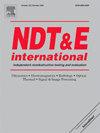利用雷达和电介质分析检测地下管道漏水
IF 4.5
2区 材料科学
Q1 MATERIALS SCIENCE, CHARACTERIZATION & TESTING
引用次数: 0
摘要
地下管道漏水不仅会造成水资源浪费造成经济损失,还会对城市基础设施造成结构性破坏。在这项研究中,我们提出了一种基于雷达的非破坏性检测方法,用于在不同尺度上定位土壤下的漏水。首先,由于雷达探测依赖于不同饱和度土壤的介电系数对比,因此了解水的存在如何影响非饱和土壤的介电常数和电导率是很重要的。为此,采用开放式探针分析了三种土壤类型:砂、壤土和砂-壤土-骨料混合物的介电特性,以建立含水饱和度与土壤介电常数之间的关系。其次,采用步进频率雷达(SFR)在受控的实验室环境中监测三种土壤类型的水泄漏引起的信号变化。最后,在一个场地(8 × 5 m2)进行现场测试,使用探地雷达(GPR)定位埋在1 m深以上的两条塑料管道中的泄漏,泄漏速度不同。基于这些多尺度实验结果,我们旨在展示基于雷达的测量在水泄漏检测中的潜在应用。此外,我们还讨论了潮湿土壤、土壤变形引起的信号变化,以及在不同情况下的检测精度。本文章由计算机程序翻译,如有差异,请以英文原文为准。
Detecting water leaks in underground pipelines by radar and dielectric analysis
Water leaks in underground pipelines not only lead to economic losses from wasted water but can also cause structural damage to urban infrastructure. In this study, we present a non-destructive radar-based detection for locating water leaks beneath the soil at various scales. First, as the radar detection relies on the dielectric contrast of soils with different saturation degrees, it is important to understand how the presence of water affects the dielectric permittivity and conductivity of unsaturated soils. To investigate this, the dielectric properties of three soil types: sand, loam, and a sand-loam-aggregate mixture, were analyzed by an open-ended probe to establish the relationship between the water saturation and the soil dielectric permittivity. Second, a stepped frequency radar (SFR) was employed in a controlled laboratory setting to monitor signal changes caused by water leaks in the three soil types. Finally, field tests were conducted at a site (8 × 5 m2), where a ground-penetrating radar (GPR) was used to locate leaks in two plastic pipelines buried over 1 m deep, with varying leak speeds. Based on these multi-scale experimental results, we aim to demonstrate the potential application of radar-based measurement for water leak detection. Additionally, we discuss the signal variations caused by wet soils, soil deformation, and the accuracy of detection in different scenarios.
求助全文
通过发布文献求助,成功后即可免费获取论文全文。
去求助
来源期刊

Ndt & E International
工程技术-材料科学:表征与测试
CiteScore
7.20
自引率
9.50%
发文量
121
审稿时长
55 days
期刊介绍:
NDT&E international publishes peer-reviewed results of original research and development in all categories of the fields of nondestructive testing and evaluation including ultrasonics, electromagnetics, radiography, optical and thermal methods. In addition to traditional NDE topics, the emerging technology area of inspection of civil structures and materials is also emphasized. The journal publishes original papers on research and development of new inspection techniques and methods, as well as on novel and innovative applications of established methods. Papers on NDE sensors and their applications both for inspection and process control, as well as papers describing novel NDE systems for structural health monitoring and their performance in industrial settings are also considered. Other regular features include international news, new equipment and a calendar of forthcoming worldwide meetings. This journal is listed in Current Contents.
 求助内容:
求助内容: 应助结果提醒方式:
应助结果提醒方式:


